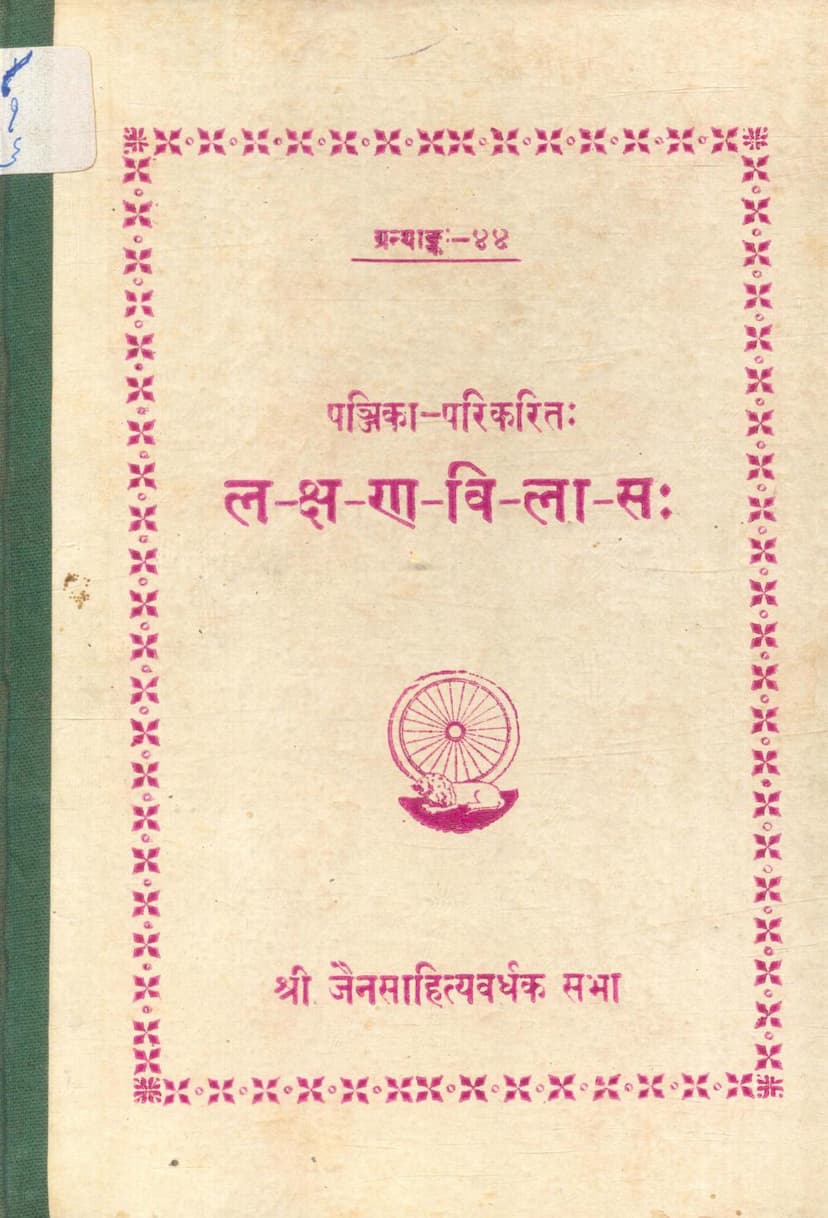Lakshan Vilas
Added to library: September 2, 2025

Summary
This is a comprehensive summary of the Jain text "Lakshan Vilas" by Dhurandharvijay Gani, published by Jain Sahityavardhak Sabha. The text is a collection of verses, each designed as a riddle or puzzle that subtly hints at or directly incorporates a sutra (rule or aphorism) from Acharya Hemachandra's renowned grammar, the "Siddha-Hema-Shabdānushāsanam."
Book Title: Lakshan Vilas Author: Dhurandharvijay Gani Publisher: Jain Sahityavardhak Sabha Catalog Link: https://jainqq.org/explore/002446/1
Core Concept: "Lakshan Vilas" is a unique and engaging work that bridges the study of grammar with poetic and riddle-like composition. The author's primary aim is to make the learning of grammatical sutras more enjoyable, memorable, and intellectually stimulating. Each verse presents a grammatical concept or sutra in a veiled or indirect manner, requiring the reader to decipher it.
Key Features and Methodologies:
The book employs a variety of creative methods to present the grammatical sutras, as detailed in the "Nivedan" (Introduction) section:
- Question-Based Riddles: Many verses pose direct or indirect questions. The answer to these questions, when correctly deduced, reveals a specific sutra from Hemachandra's grammar. The challenge lies in finding words or concepts that are both relevant to the verse's poetry and pertinent to a grammatical rule. (Example: Slokas with numbers 2, 3, 5, 6, 8, 10, 12, 13, 17, 19, 20, 22, 23, 24, 25, 26, 30, 34, 35, 36, 38, 40, 46, 49, 54, 55, 56, 82, 95, 99, 103).
- Letter Manipulation: Some verses involve adding, removing, or substituting letters from a given word or phrase to arrive at the intended sutra. (Example: Slokas 4, 79, 96).
- Sutra Embedding: In certain verses, the letters of the sutra are literally woven into the verse's text, but in a scrambled order, requiring the reader to reassemble them. (Example: Slokas 7, 11, 18, 21, 28, 37, 43, 45, 47, 75, 78, 80, 84).
- Cryptic Clues: Some verses provide only partial hints or clues to the sutra, demanding significant effort and a deep understanding of the grammar to uncover the complete rule. (Example: Slokas 14, 15, 27, 39, 42, 5, 7, 88, 90, 94, 101).
- Letter Play: Specific letters of a sutra are presented in a unique or disguised manner, and the reader must collect them to form the intended sutra. (Example: Slokas 9, 74, 98).
- Synonym Substitution: A sutra might be presented by using synonyms for its constituent words. (Example: Sloka 16).
- Word or Phrase Clues: Certain verses provide specific words or phrases as clues, and by applying grammatical transformations or understanding their context, the sutra can be derived. (Example: Slokas 29, 57, 58, 88).
- Multiple Interpretations: Some sutras are chosen for their multiple meanings, and the verse guides the reader to the specific intended meaning within the context of the grammar. (Example: Sloka 60).
- Reverse Engineering: The verse might describe a process or result, and by reversing it or applying a specific grammatical operation, the original sutra can be found. (Example: Sloka 92).
- Verse Structure and Meter: The arrangement of words within the verse, the meter, or even specific poetic devices are used as pointers to the sutras.
Purpose and Value:
- Engagement in Grammar Study: The primary goal is to combat the perceived dryness of grammar study by making it a playful and intellectual pursuit.
- Reinforcement of Knowledge: By solving these riddles, students of grammar are expected to reinforce their understanding and memorization of Hemachandra's sutras.
- Intellectual Stimulation: The "Lakshan Vilas" is designed to sharpen the reader's intellect and analytical skills.
- Appreciation of Poetic-Grammatical Synthesis: The work showcases a remarkable fusion of poetry and grammatical science, a tradition found in Sanskrit literature.
- Accessibility: While requiring a foundational knowledge of Sanskrit grammar, particularly Hemachandra's work, the introductory sections and the "Panjika" (commentary) help readers navigate the complex riddles.
Author and Context:
- Dhurandharvijay Gani is presented as a highly erudite scholar and a dedicated follower of Jain traditions. The book is a testament to his deep knowledge of both grammar and poetry, and his desire to contribute to religious and literary scholarship.
- The work is dedicated to his spiritual lineage and acknowledges the inspiration and guidance received from his gurus.
- The inclusion of forewords and introductions by esteemed scholars like Bhanubhai Vyas and Ramprasad P. Bakshi highlights the significance and quality of the work. Ramprasad P. Bakshi, in particular, emphasizes the book's ability to grip the reader and make grammar study an enjoyable "festive entertainment."
Overall Significance:
"Lakshan Vilas" is more than just a grammar primer; it's a work of intellectual art. It demonstrates how complex subjects can be made accessible and enjoyable through creativity and a deep understanding of both the subject matter and the art of communication. It serves as a valuable resource for students of Sanskrit grammar, particularly those studying the "Siddha-Hema-Shabdānushāsanam," and a delightful read for anyone interested in the intersection of literature and linguistic science. The book is praised for its innovative approach and the author's mastery in weaving grammatical rules into engaging verses.